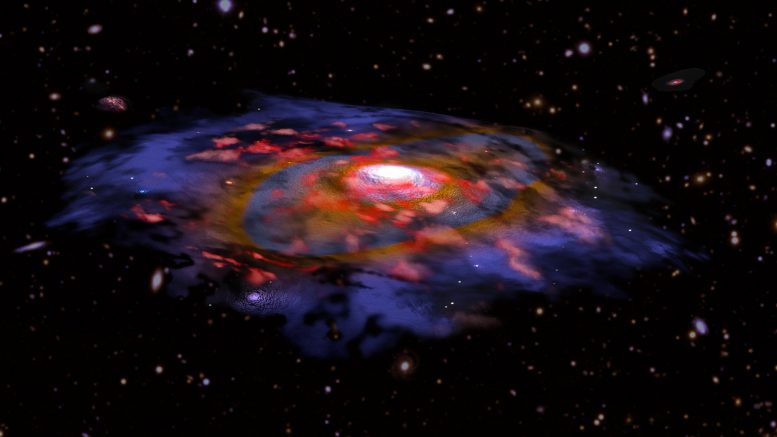
Artist’s illustration of a galaxy in the early universe that is very dusty and shows the first signs of a rotationally supported disk. In this image, the red color represents gas, and blue/brown represents dust as seen in radio waves with ALMA. Many other galaxies are visible in the background, based on optical data from VLT and Subaru. Credit: B. Saxton NRAO/AUI/NSF, ESO, NASA/STScI; NAOJ/Subaru
Massive galaxies were already much more mature in the early universe than previously expected. This was shown by an international team of astronomers who studied 118 distant galaxies with the Atacama Large Millimeter/submillimeter Array (ALMA).
Most galaxies formed when the universe was still very young. Our own galaxy, for example, likely started forming 13.6 billion years ago, in our 13.8 billion-year-old universe. When the universe was only ten percent of its current age (1-1.5 billion years after the Big Bang), most of the galaxies experienced a “growth spurt.” During this time, they built up most of their stellar mass and other properties, such as dust, heavy element content, and spiral-disk shapes, that we see in today’s galaxies. Therefore, if we want to learn how galaxies like our Milky Way formed, it is important to study this epoch.
Massive galaxies were already much more mature in the early universe than previously expected. This was shown by an international team of astronomers who studied 118 distant galaxies with the Atacama Large Millimeter/submillimeter Array (ALMA). Credit: National Radio Astronomy Observatory
In a survey called ALPINE (the ALMA Large Program to Investigate C+ at Early Times), an international team of astronomers studied 118 galaxies experiencing such a “growth spurt” in the early universe. “To our surprise, many of them were much more mature than we had expected,” said Andreas Faisst of the Infrared Processing and Analysis Center (IPAC) at the California Institute of Technology (Caltech).
Galaxies are considered more “mature” than “primordial” when they contain a significant amount of dust and heavy elements. “We didn’t expect to see so much dust and heavy elements in these distant galaxies,” said Faisst. Dust and heavy elements (defined by astronomers as all elements heavier than hydrogen and helium) are considered to be a by-product of dying stars. But galaxies in the early universe have not had much time to build stars yet, so astronomers don’t expect to see much dust or heavy elements there either.
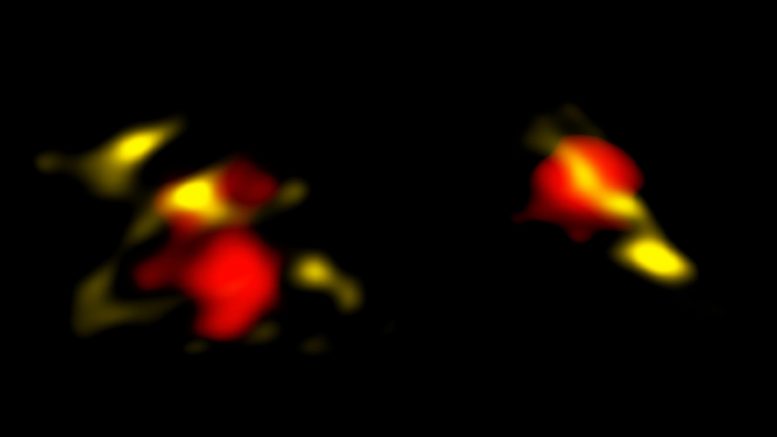
These are two of the galaxies in the early universe that ALMA observed in radio waves. The galaxies are considered more “mature” than “primordial” because they contain large amounts of dust (yellow). ALMA also revealed the gas (red), which is used to measure the obscured star-formation and motions in the galaxies. Credit: B. Saxton NRAO/AUI/NSF, ALMA (ESO/NAOJ/NRAO), ALPINE team
“From previous studies, we understood that such young galaxies are dust-poor,” said Daniel Schaerer of the University of Geneva in Switzerland. “However, we find around 20 percent of the galaxies that assembled during this early epoch are already very dusty and a significant fraction of the ultraviolet light from newborn stars is already hidden by this dust,” he added.
Many of the galaxies were also considered to be relatively grown-up because they showed a diversity in their structures, including the first signs of rotationally supported disks – which may later lead to galaxies with a spiral structure as is observed in galaxies such as our Milky Way. Astronomers generally expect that galaxies in the early universe look like train wrecks because they often collide. “We see many galaxies that are colliding, but we also see a number of them rotating in an orderly fashion with no signs of collisions,” said John Silverman of the Kavli Institute for the Physics and Mathematics of the Universe in Japan.
Artist’s animation of a galaxy in the early universe that is very dusty and shows the first signs of a rotationally supported disk. In this image, the red color represents gas, and blue/brown represents dust as seen in radio waves with ALMA. Many other galaxies are visible in the background, based on optical data from VLT and Subaru. Credit: B. Saxton NRAO/AUI/NSF, ESO, NASA/STScI; NAOJ/Subaru
ALMA has spotted very distant galaxies before, such as MAMBO-9 (a very dusty galaxy) and the Wolfe Disk (a galaxy with a rotating disk). But it was hard to say whether these discoveries were unique, or whether there were more galaxies like them out there. ALPINE is the first survey that enabled astronomers to study a significant number of galaxies in the early universe, and it shows that they might evolve faster than expected. But the scientists don’t yet understand how these galaxies grew up so fast, and why some of them already have rotating disks.
Observations from ALMA were crucial for this research because the radio telescope can see the star formation that is hidden by dust and trace the motion of gas emitted from star-forming regions. Surveys of galaxies in the early universe commonly use optical and infrared telescopes. These allow the measurement of the unobscured star formation and stellar masses. However, these telescopes have difficulties measuring dust obscured regions, where stars form, or the motions of gas in these galaxies. And sometimes they don’t see a galaxy at all. “With ALMA we discovered a few distant galaxies for the first time. We call these Hubble-dark as they could not be detected even with the Hubble telescope,” said Lin Yan of Caltech.
To learn more about distant galaxies, the astronomers want to point ALMA at individual galaxies for a longer time. “We want to see exactly where the dust is and how the gas moves around. We also want to compare the dusty galaxies to others at the same distance and figure out if there might be something special about their environments,” added Paolo Cassata of the University of Padua in Italy, formerly at the Universidad de Valparaíso in Chile.
ALPINE is the first and largest multi-wavelength survey of galaxies in the early universe. For a large sample of galaxies the team collected measurements in the optical (including Subaru, VISTA, Hubble, Keck and VLT), infrared (Spitzer), and radio (ALMA). Multi-wavelength studies are needed to get the full picture of how galaxies are built up. “Such a large and complex survey is only possible thanks to the collaboration between multiple institutes across the globe,” said Matthieu Béthermin of the Laboratoire d’Astrophysique de Marseille in France.
Reference: “The ALPINE-ALMA [CII] survey – Survey strategy, observations, and sample properties of 118 star-forming galaxies at 4 < z < 6” by O. Le Fèvre, M. Béthermin, A. Faisst, G. C. Jones, P. Capak, P. Cassata, J. D. Silverman, D. Schaerer, L. Yan, R. Amorin, S. Bardelli, M. Boquien, A. Cimatti, M. Dessauges-Zavadsky, M. Giavalisco, N. P. Hathi, Y. Fudamoto, S. Fujimoto, M. Ginolfi, C. Gruppioni, S. Hemmati, E. Ibar, A. Koekemoer, Y. Khusanova, G. Lagache, B. C. Lemaux, F. Loiacono, R. Maiolino, C. Mancini, D. Narayanan, L. Morselli, Hugo Méndez-Hernàndez, P. A. Oesch, F. Pozzi, M. Romano, D. Riechers, N. Scoville, M. Talia, L. A. M. Tasca, R. Thomas, S. Toft, L. Vallini, D. Vergani, F. Walter, G. Zamorani and E. Zucca, 21 October 2020, Astronomy & Astrophysics.
DOI: 10.1051/0004-6361/201936965
The National Radio Astronomy Observatory is a facility of the National Science Foundation, operated under cooperative agreement by Associated Universities, Inc.

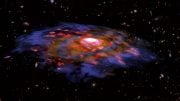
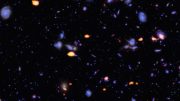
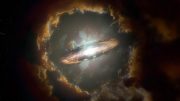
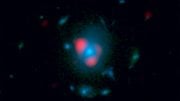
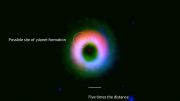
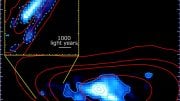
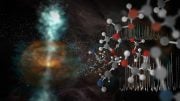
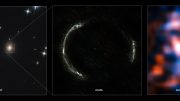
Scientists previously confirmed that the massive ‘black holes’ are in the same place. This can be understood by the Burbidge theory of expanding/collapsing universe.
If you mean that it looks like supermassive black holes develop with the galaxies, that claim is correct.
It would be nice if any claims are supported with references, especially if they are contrary and fringe. The only successful fact and theory of the universe is that it is expanding under the inflationary hot big bang model [LCDM model; “Lambda-CDM model” @ Wikipedia]. On Burbidge: “In his late years, Burbidge was known mostly for his alternative cosmology “quasi-steady state theory”, which contradicts the Big Bang theory.[6]” [“Geoffrey Burbidge” @ Wikipedia] So the latter claim is incorrect – it cannot be understood that way, and we understand why it can’t.
This is a topic that lies right at the science edge, early galaxy and star formation history.
The ALPINE-ALMA [CII] survey puts out two papers that show early galaxy maturity by way of dust production as well as diversity and mergers. [Y. Fudamoto et al, The ALPINE-ALMA [CII] survey, Astronomy & Astrophysics (2020). DOI: 10.1051/0004-6361/202038163; O. Le Fèvre et al, The ALPINE-ALMA [CII] survey, Astronomy & Astrophysics (2020). DOI: 10.1051/0004-6361/201936965]
From the diversity paper: “We find a surprisingly wide range of galaxy types, including 40% mergers, 20% extended and dispersiondominated, 13.3% rotating discs, and 10.7% compact, with the remaining 16% too faint to be classified. This diversity of types indicates that several physical processes are at work for the assembly of mass in these galaxies, first and foremost, for galaxy merging. While galaxy merging is commonly associated with starbursts above the main sequence, at least up to z ∼ 3, merging systems in ALPINE at z ∼ 4.7 lie mainly on the MS, and therefore, merging is also a dominant process for normal SFGs at this epoch.”
From the dust paper: “”Taken together, our results indicate that the dust attenuation properties evolve rapidly between z ∼ 6, at the end of cosmic reionization, to z ∼ 2 − 3, around the peak of cosmic star formation. It is possible that we are seeing a transition to supernovae (SNe) driven dust production at z >= 3, which is predicted theoretically given the limited time available for dust production in lower mass stars (e.g., Todini & Ferrara 2001; Nozawa et al. 2003; Schneider et al. 2004).”
So, supernovas and mergers to the rescue, pointing to the main channels for how the early universe grew up.
I believe that if there’s a dust cloud it would clearly indicate activity around the blacksphere at the center of the galaxie. And it’s clearly the event horizon that’s being observed and the flashes are supernova. Which in turn would indicate that the galaxie is alive and active. Which in turn would indicate a real problem with your big bang theory not whats happening in that region of space. We know that blacksphere’s create galaxy’s and are the reason for creation of stars in the first place. It’s your time line that is wrong and not what you or we are observing.
The answers we seek are ties in with the age of the blacksphere’s them selves. As the process of making a galaxie starts with a blacksphere that’s where we should be looking for answers. As I think we can’t do that at this time maybe we should be looking at the stars closest to them for metalousity so we might take a guess at the age of the blacksphere’s them selves. And it would not surprise me that the blacksphere’s are much older than the big bang theory itself. Which would indicate that your time line is wrong.
And also said galaxie is probably feeding so look for the Jets coming out of its pole if you can. Blacksphere’s collect gas and dust from the event that created the blacksphere itself but in theory those very first really big hydrogen stars should have been pure. So what ever their made of should be pure. So if that’s the case the stars closest to them should be almost metalousity free. The farther away from the center the younger the star. I can almost see really big stars liquid stars in the beginning no light moving through space. And then something happens and those stars egnite with such force and heat the the universe itself has no choice but to expand and create a vacuum so the spheres could gather all the material back onto them selves and create galaxies and the stars and planets and US. Merry Christmas to you all keep up the great work and thanks.
Think like when you put a drop of cooking oil in a pot of water